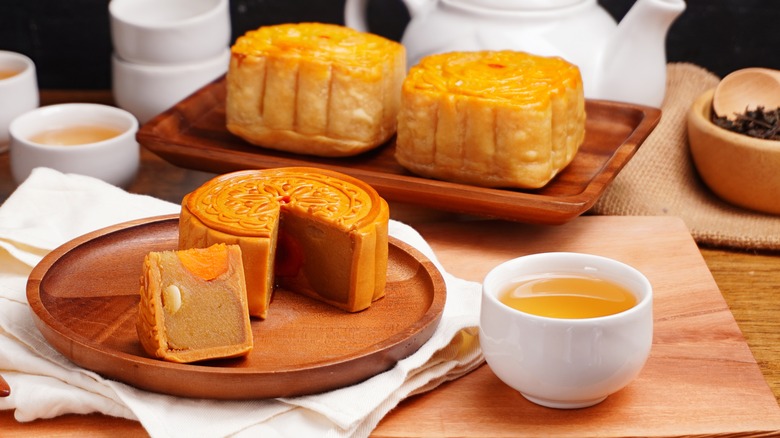The Sweet Allure Of 'Not Too Sweet' Desserts In Asian Baking
Stepping into a Chinese bakery, you notice pastries on display that diverge from conventional Western dessert paradigms. Instead of intensely saccharine-frosted cupcakes and icing-covered cookies, airy spongecakes studded with pork floss, glossy sweet buns enveloping hot dogs, Swiss roll cakes brimming with scallions, sweet mayo, and eggs, and not-too-sweet buttery black sesame and matcha cookies greet you.
This eclectic assortment illustrates a defining characteristic of East Asian baking: a penchant for desserts that balance sweetness with elements of savory, umami, and sometimes spicy flavors. Thus with the region's desserts, it's not odd to find treats like hoisin-sauce-glazed chocolate cakes.
One root of the "not too sweet" flavor profile lies in the region's history. In Asia, sugar was first refined in subtropical India, but the country did not find its way to trading it with others on the continent until the late 1960s. Consequently, desserts across Asia, but particularly China, were traditionally made with natural sweeteners like honey or fruits, such as jujubes, rather than refined sugar.
Asian baking is all about balancing and harmonizing flavors
This practice generally persists today in Asian baking, and unsurprisingly, desserts with a "not too sweet" profile are trending and gaining global popularity. In East Asian and Asian diaspora cultures, "not too sweet" is neither merely descriptive nor critical — it's the ultimate compliment that the baker has achieved a nuanced balance of flavors.
In contrast to Western culture, bread and pastries are more often enjoyed as treats than everyday meal staples. And desserts are considered an integral part of the meal, which brings balance to the other courses rather than being treated as a course of their own. Hence, when you enjoy dim sim, you can have an egg tart or sesame ball at any time, not just after the meal.
This cultural perspective is another reason for the unique flavor profiles observed in Asian baking, like savory bread, such as sausage and pork floss buns, carrying a hint of sweetness, while sweet desserts, like mochi, err on the side of being "not too sweet."
The mooncake is another signature example of a "not too sweet" dessert. This Chinese specialty often features a dense and subtly sweet lotus seed or red bean paste filling balanced by a savory salted egg yolk in the middle for a small, full-moon-shaped treat meant to be shared.
'Not too sweet' desserts are trending and here to stay
The "not too sweet" profile isn't just a trend — it's a key part of the long-standing culinary tradition in Asian baking. So, as you embark on this sweet journey of discovery, remember that each mellow bite is a delicious connection to a rich, storied tradition. That subtly sweet sesame ball is not just a dessert — it's the result of age-old gastronomic art.
Though, it's important to note that not all Asian desserts fall under the "not too sweet" category. Some desserts, such as India's gulab jamun and the Philippines' Brazo de Mercedes, are celebrated for their pronounced sweetness.
Those intrigued by the "not too sweet" character of many Asian desserts, should check out Abi Balingit's "Mayumu: Filipino American Desserts Remixed," which is packed with traditional and fusion recipes focused on balancing dessert flavors. Joining an online baking community can be another worthwhile step. These platforms often offer resources, techniques, and inspiration within a supportive and inclusive learning environment. And if you would just like to experience what the tempered dessert hype is all about, experience the pastries firsthand by supporting local Asian bakeries and sampling their vast array of delicacies, like an Asian fruit cream cake.


